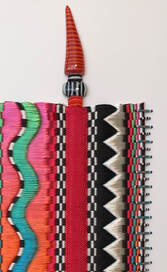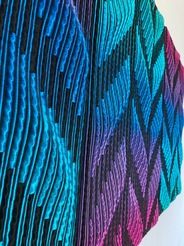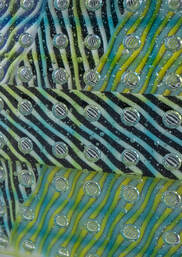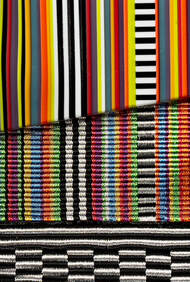My Process
|
My smaller weavings have a warp of hand dyed viscose rayon and a weft of monofilament, mylar, plastic and electrical cord. They are framed and mounted on mat board or wool fabric. These weavings are 5 layers, with 2 of the layers being black and white and the others dyed in color progressions. As I’ve begun to work in glass, I’ve been incorporating glass elements in the weaving. |
|
The larger weavings use 2 or 3 layers of rayon warp, handdyed in color progressions and layered on the loom. The wefts are varied - always electrical cord and rayon or monofilament. The cord is either completely twisted, or is twisted in areas and left flat in others that relate to the colors they are woven beneath. As my exploration in the creation of three-dimensional forms in glass has grown, it has developed my interest in creating more dimension in my weaving. I find myself stuffing, quilting and beading the larger weavings to create this dimension. |
|
When I started kiln formed glass it was very influenced by the designs I had been doing in fiber. As my work developed, I started working with the bubble technique made by forming a grid of 2 mm stringer (rods of glass) between 2 sheets of glass to capture bubbles. Although not “woven” glass it certainly reflects the structure of weaving. If I then used transparent stringer I could use the bubbles formed to function as a lens to distort pattern, either of glass or woven fiber.
|
|
One way to play with the optics of the bubble is to stack up glass, beginning with patterned glass, then interspersing pattern among clear glass, and then topping with a premade bubble piece. All of this is dammed (contained so it doesn’t flow out as it melts together in the kiln). The glass sculptures are then either mounted to a base or slumped into a curve, which can create further visual complexity by distorting the shape of the bubble.
|




